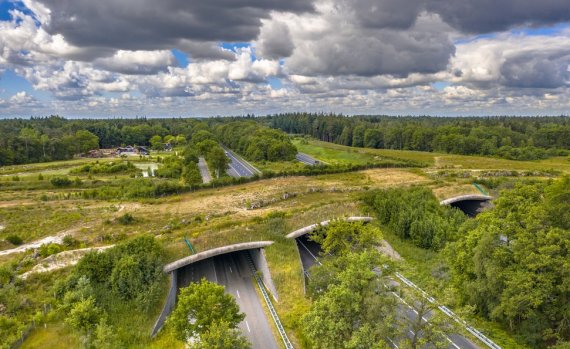Wildlife crossing in the Dwingelderveld near Beilen (Drenthe) © Shutterstock
This is the result of a study on the cost-efficiency of wildlife crossings and passages for fauna, in which WUR participated. Many such constructions, which are designed to connect nature reserves separated by roads, are found in the Netherlands. But do they work? Is it possible to objectively measure such ecological improvements and compare them with other environmental interventions that serve to improve regional ecologies?
Defragmentation
The multi-year Defragmentation plan that was initiated in 2005 and recently concluded is the direct cause for these questions. Within this programme, 176 locations where nature areas separated by highways, waterways or railways were targeted. These areas were reconnected through a network of wildlife crossings, fauna tunnels and other provisions, for a total sum of 283 million euros.
The effect of these measures was mapped by the researchers, using a variety of criteria. One such test calculates the increase in the environmental quality of an area after a tunnel or crossing is constructed. This increase is expressed in terms of hectares with high biodiversity value. The sum of all measures led to a rise in 1734 hectares. Note: this refers to hectares with an improved nature quality, not hectares of new nature.
Insurmountable barrier
This sounds easier than it is. ‘Terrain quality depends on a myriad of different factors’, says Rogier Pouwels, involved in the study on behalf or WUR. ‘A road is not a problem of equal proportion for all species. For some species, for whom roads are an insurmountable barrier, this ecological improvement is a wonderful and quick method.’
In many places, there is but one solution to bottlenecks: increasing the size of the habitat by constructing a wildlife crossing
Rogier Pouwels, WUR-ecologist
The altered quality of a region was compared to data on species and populations in the connected areas, and the usage of the wildlife corridors. The results pertaining to wildlife crossings were then compared to measures directed at improving nature management, and efforts to transform farming lands into nature areas. This yielded some surprising conclusions.
A single solution
Wildlife crossings appear to be an extremely expensive way to create added value in nature. In ecological terms, every euro spent on nature management has a return sevenfold higher than if the same euro is spent on wildlife crossings. But, Pouwels stresses, this is no reason to argue against the crossings. ‘In many places, there is but one solution to bottlenecks: increasing the size of the habitat by constructing a wildlife crossing.’
Wildlife crossings and fauna tunnels can be introduced relatively rapidly and easily. Pouwels also points out that the research method is limited to recording improvements in local ecological quality. ‘We have not considered the possible effects of wildlife crossings to the ecology at a larger scale, for example, in terms of genetic exchanges between populations or adaptation to climate change.’

